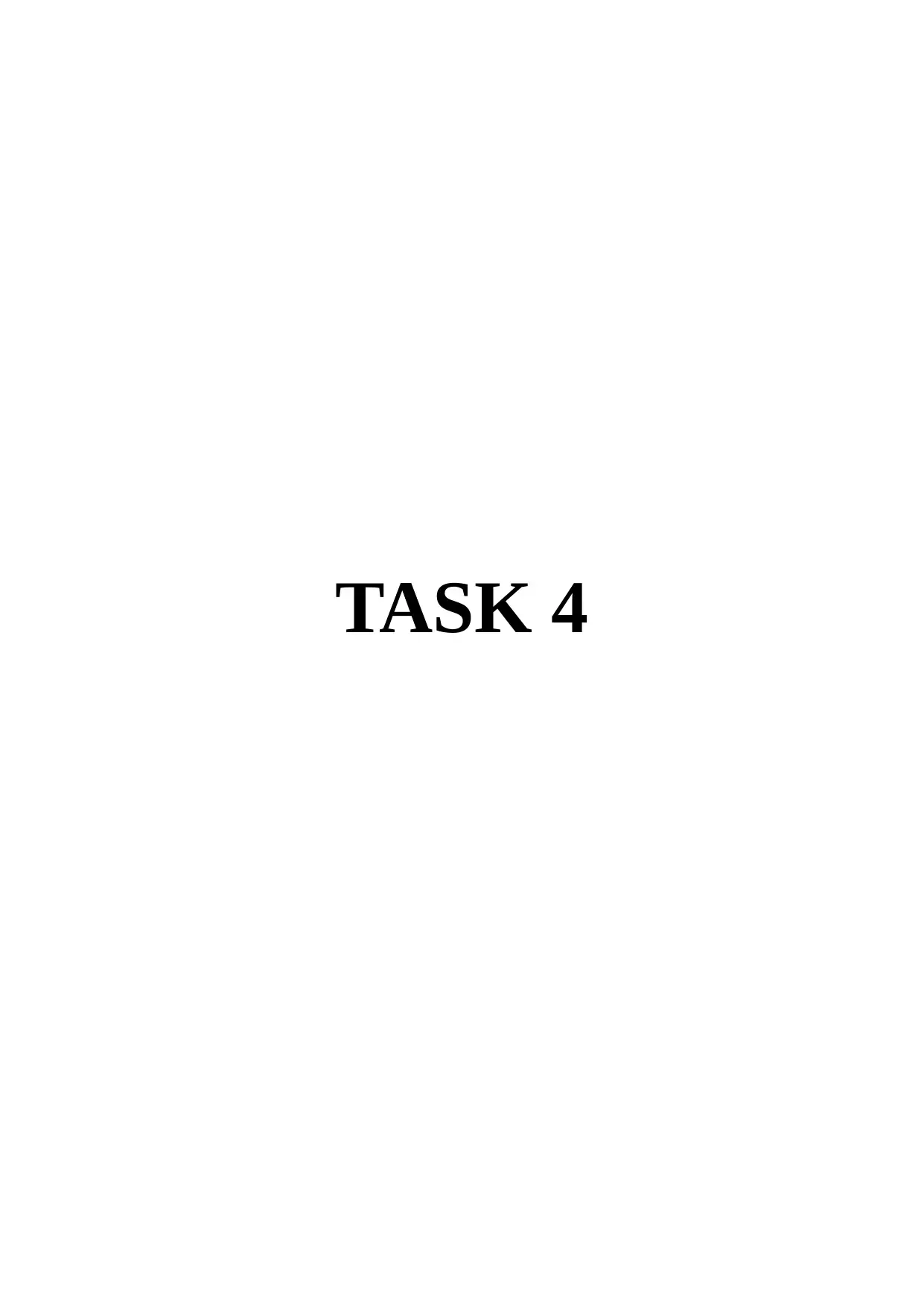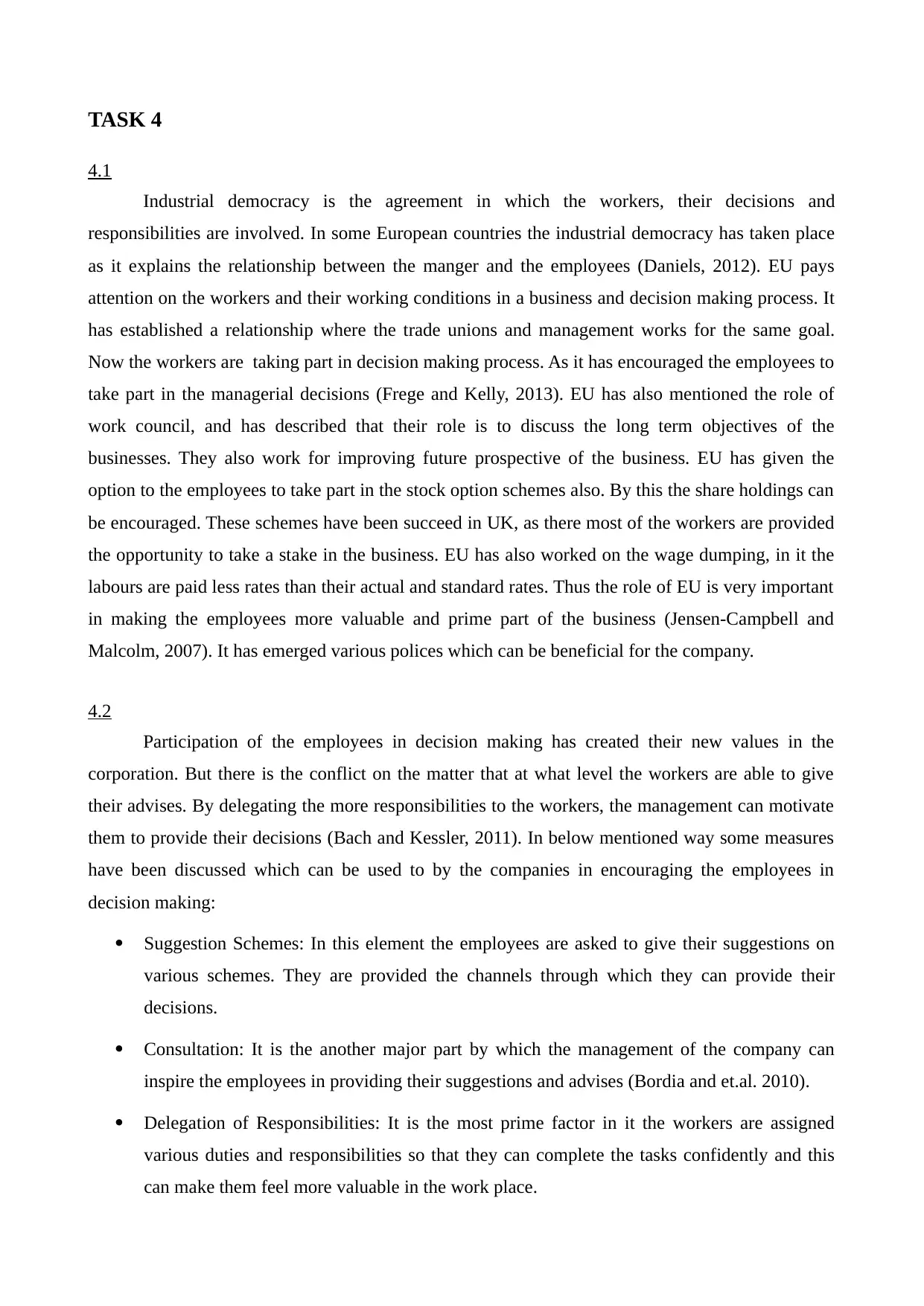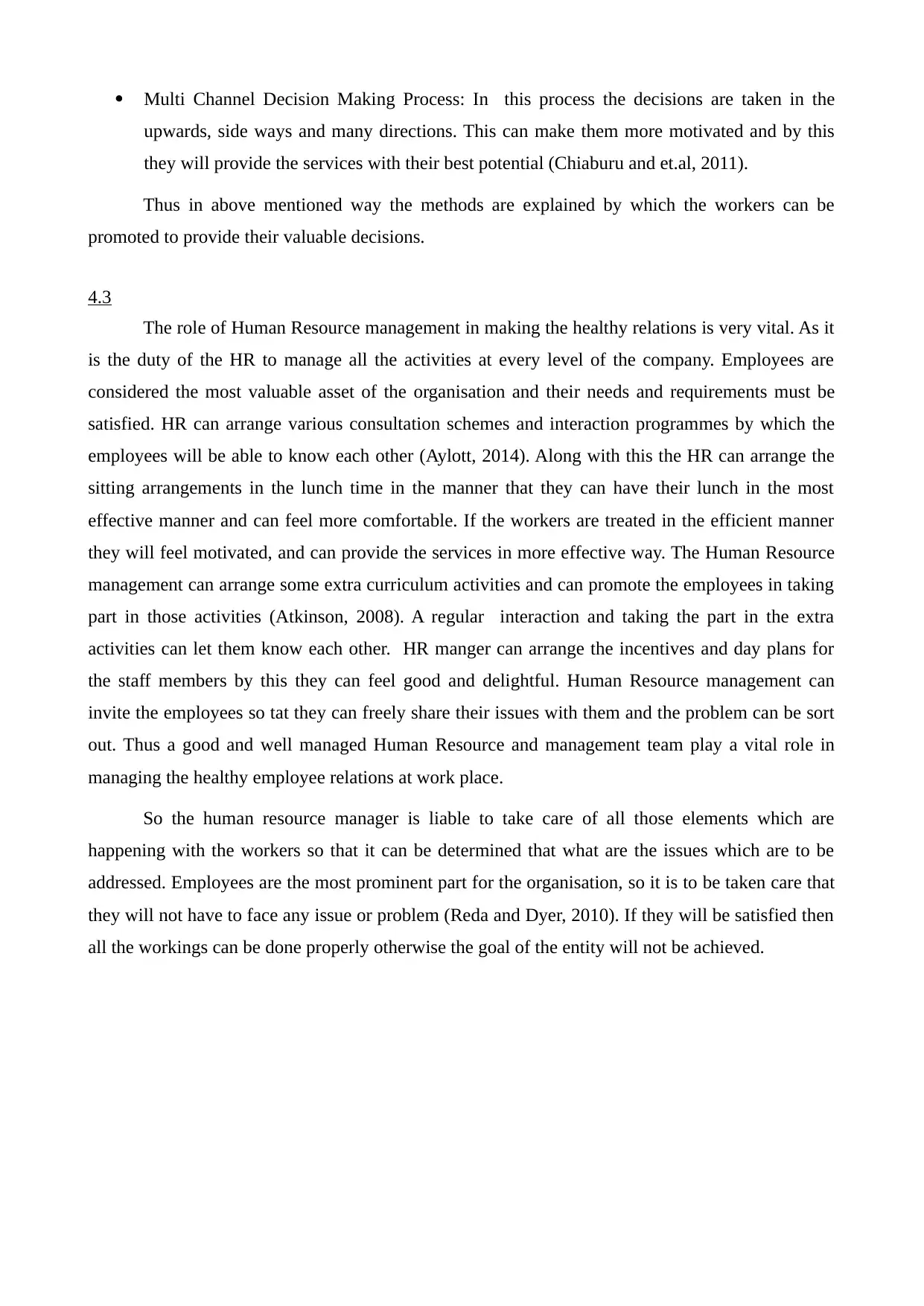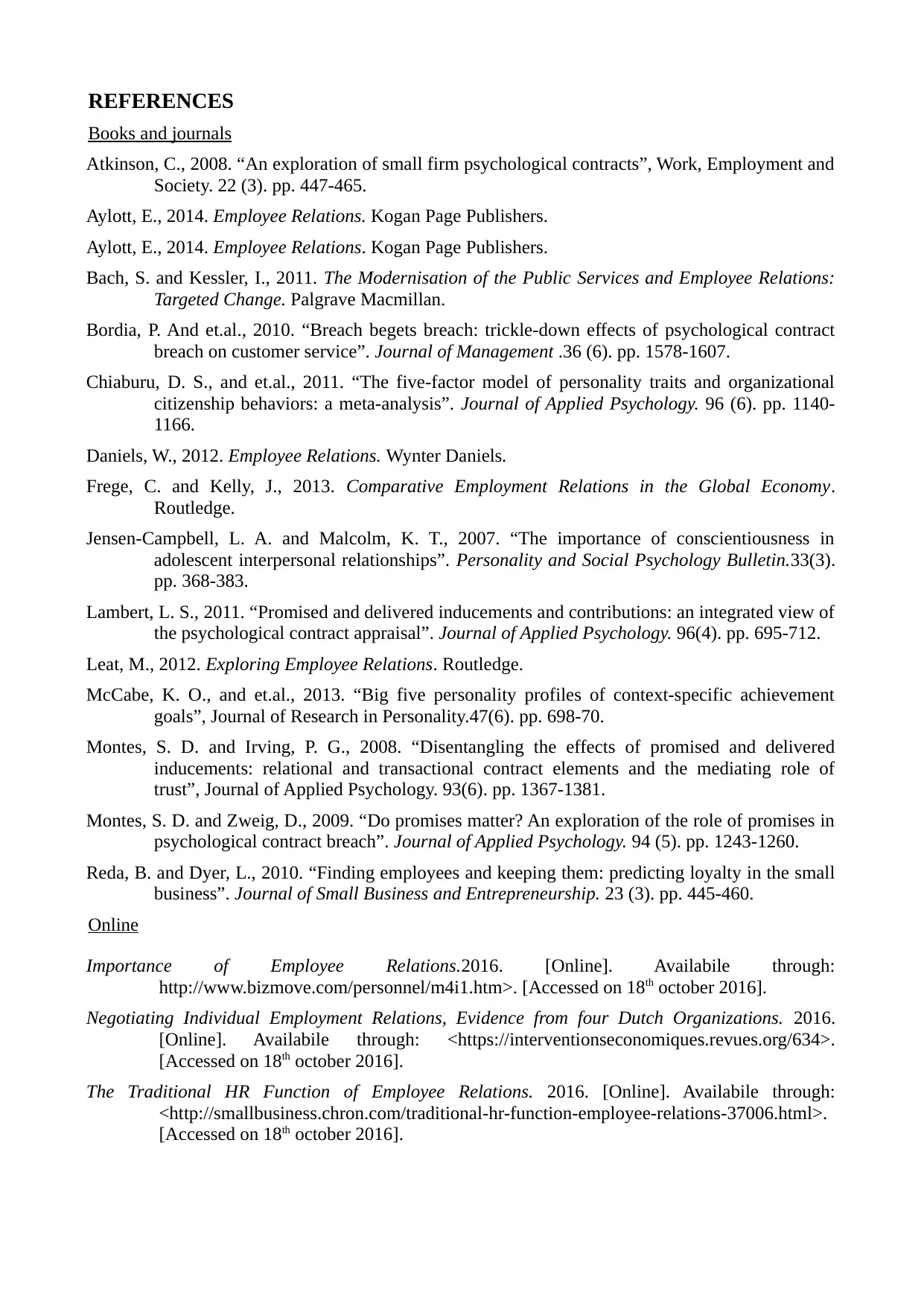BTEC HND Business: Unit 22 Employee Relations Report Analysis
VerifiedAdded on 2020/01/07
|4
|1435
|143
Report
AI Summary
This report delves into the multifaceted realm of employee relations, commencing with an exploration of industrial democracy and its implications, particularly within the context of European Union policies. It examines the evolution of employee involvement in decision-making processes, highlighting the significance of worker participation and the impact of EU regulations on fostering a collaborative environment between management and employees. The report further investigates various methods employed to encourage employee contributions, such as suggestion schemes, consultation, and the delegation of responsibilities. A substantial portion of the report is dedicated to the crucial role of Human Resource Management in cultivating and maintaining healthy employee relations, emphasizing the importance of activities, incentives and open communication. The report underscores the significance of HR in addressing employee needs and fostering a positive workplace environment. Overall, the report provides a comprehensive overview of key aspects of employee relations, emphasizing their importance for organizational success.

TASK 4
Paraphrase This Document
Need a fresh take? Get an instant paraphrase of this document with our AI Paraphraser

TASK 4
4.1
Industrial democracy is the agreement in which the workers, their decisions and
responsibilities are involved. In some European countries the industrial democracy has taken place
as it explains the relationship between the manger and the employees (Daniels, 2012). EU pays
attention on the workers and their working conditions in a business and decision making process. It
has established a relationship where the trade unions and management works for the same goal.
Now the workers are taking part in decision making process. As it has encouraged the employees to
take part in the managerial decisions (Frege and Kelly, 2013). EU has also mentioned the role of
work council, and has described that their role is to discuss the long term objectives of the
businesses. They also work for improving future prospective of the business. EU has given the
option to the employees to take part in the stock option schemes also. By this the share holdings can
be encouraged. These schemes have been succeed in UK, as there most of the workers are provided
the opportunity to take a stake in the business. EU has also worked on the wage dumping, in it the
labours are paid less rates than their actual and standard rates. Thus the role of EU is very important
in making the employees more valuable and prime part of the business (Jensen-Campbell and
Malcolm, 2007). It has emerged various polices which can be beneficial for the company.
4.2
Participation of the employees in decision making has created their new values in the
corporation. But there is the conflict on the matter that at what level the workers are able to give
their advises. By delegating the more responsibilities to the workers, the management can motivate
them to provide their decisions (Bach and Kessler, 2011). In below mentioned way some measures
have been discussed which can be used to by the companies in encouraging the employees in
decision making:
Suggestion Schemes: In this element the employees are asked to give their suggestions on
various schemes. They are provided the channels through which they can provide their
decisions.
Consultation: It is the another major part by which the management of the company can
inspire the employees in providing their suggestions and advises (Bordia and et.al. 2010).
Delegation of Responsibilities: It is the most prime factor in it the workers are assigned
various duties and responsibilities so that they can complete the tasks confidently and this
can make them feel more valuable in the work place.
4.1
Industrial democracy is the agreement in which the workers, their decisions and
responsibilities are involved. In some European countries the industrial democracy has taken place
as it explains the relationship between the manger and the employees (Daniels, 2012). EU pays
attention on the workers and their working conditions in a business and decision making process. It
has established a relationship where the trade unions and management works for the same goal.
Now the workers are taking part in decision making process. As it has encouraged the employees to
take part in the managerial decisions (Frege and Kelly, 2013). EU has also mentioned the role of
work council, and has described that their role is to discuss the long term objectives of the
businesses. They also work for improving future prospective of the business. EU has given the
option to the employees to take part in the stock option schemes also. By this the share holdings can
be encouraged. These schemes have been succeed in UK, as there most of the workers are provided
the opportunity to take a stake in the business. EU has also worked on the wage dumping, in it the
labours are paid less rates than their actual and standard rates. Thus the role of EU is very important
in making the employees more valuable and prime part of the business (Jensen-Campbell and
Malcolm, 2007). It has emerged various polices which can be beneficial for the company.
4.2
Participation of the employees in decision making has created their new values in the
corporation. But there is the conflict on the matter that at what level the workers are able to give
their advises. By delegating the more responsibilities to the workers, the management can motivate
them to provide their decisions (Bach and Kessler, 2011). In below mentioned way some measures
have been discussed which can be used to by the companies in encouraging the employees in
decision making:
Suggestion Schemes: In this element the employees are asked to give their suggestions on
various schemes. They are provided the channels through which they can provide their
decisions.
Consultation: It is the another major part by which the management of the company can
inspire the employees in providing their suggestions and advises (Bordia and et.al. 2010).
Delegation of Responsibilities: It is the most prime factor in it the workers are assigned
various duties and responsibilities so that they can complete the tasks confidently and this
can make them feel more valuable in the work place.

Multi Channel Decision Making Process: In this process the decisions are taken in the
upwards, side ways and many directions. This can make them more motivated and by this
they will provide the services with their best potential (Chiaburu and et.al, 2011).
Thus in above mentioned way the methods are explained by which the workers can be
promoted to provide their valuable decisions.
4.3
The role of Human Resource management in making the healthy relations is very vital. As it
is the duty of the HR to manage all the activities at every level of the company. Employees are
considered the most valuable asset of the organisation and their needs and requirements must be
satisfied. HR can arrange various consultation schemes and interaction programmes by which the
employees will be able to know each other (Aylott, 2014). Along with this the HR can arrange the
sitting arrangements in the lunch time in the manner that they can have their lunch in the most
effective manner and can feel more comfortable. If the workers are treated in the efficient manner
they will feel motivated, and can provide the services in more effective way. The Human Resource
management can arrange some extra curriculum activities and can promote the employees in taking
part in those activities (Atkinson, 2008). A regular interaction and taking the part in the extra
activities can let them know each other. HR manger can arrange the incentives and day plans for
the staff members by this they can feel good and delightful. Human Resource management can
invite the employees so tat they can freely share their issues with them and the problem can be sort
out. Thus a good and well managed Human Resource and management team play a vital role in
managing the healthy employee relations at work place.
So the human resource manager is liable to take care of all those elements which are
happening with the workers so that it can be determined that what are the issues which are to be
addressed. Employees are the most prominent part for the organisation, so it is to be taken care that
they will not have to face any issue or problem (Reda and Dyer, 2010). If they will be satisfied then
all the workings can be done properly otherwise the goal of the entity will not be achieved.
upwards, side ways and many directions. This can make them more motivated and by this
they will provide the services with their best potential (Chiaburu and et.al, 2011).
Thus in above mentioned way the methods are explained by which the workers can be
promoted to provide their valuable decisions.
4.3
The role of Human Resource management in making the healthy relations is very vital. As it
is the duty of the HR to manage all the activities at every level of the company. Employees are
considered the most valuable asset of the organisation and their needs and requirements must be
satisfied. HR can arrange various consultation schemes and interaction programmes by which the
employees will be able to know each other (Aylott, 2014). Along with this the HR can arrange the
sitting arrangements in the lunch time in the manner that they can have their lunch in the most
effective manner and can feel more comfortable. If the workers are treated in the efficient manner
they will feel motivated, and can provide the services in more effective way. The Human Resource
management can arrange some extra curriculum activities and can promote the employees in taking
part in those activities (Atkinson, 2008). A regular interaction and taking the part in the extra
activities can let them know each other. HR manger can arrange the incentives and day plans for
the staff members by this they can feel good and delightful. Human Resource management can
invite the employees so tat they can freely share their issues with them and the problem can be sort
out. Thus a good and well managed Human Resource and management team play a vital role in
managing the healthy employee relations at work place.
So the human resource manager is liable to take care of all those elements which are
happening with the workers so that it can be determined that what are the issues which are to be
addressed. Employees are the most prominent part for the organisation, so it is to be taken care that
they will not have to face any issue or problem (Reda and Dyer, 2010). If they will be satisfied then
all the workings can be done properly otherwise the goal of the entity will not be achieved.
⊘ This is a preview!⊘
Do you want full access?
Subscribe today to unlock all pages.

Trusted by 1+ million students worldwide

REFERENCES
Books and journals
Atkinson, C., 2008. “An exploration of small firm psychological contracts”, Work, Employment and
Society. 22 (3). pp. 447-465.
Aylott, E., 2014. Employee Relations. Kogan Page Publishers.
Aylott, E., 2014. Employee Relations. Kogan Page Publishers.
Bach, S. and Kessler, I., 2011. The Modernisation of the Public Services and Employee Relations:
Targeted Change. Palgrave Macmillan.
Bordia, P. And et.al., 2010. “Breach begets breach: trickle-down effects of psychological contract
breach on customer service”. Journal of Management .36 (6). pp. 1578-1607.
Chiaburu, D. S., and et.al., 2011. “The five-factor model of personality traits and organizational
citizenship behaviors: a meta-analysis”. Journal of Applied Psychology. 96 (6). pp. 1140-
1166.
Daniels, W., 2012. Employee Relations. Wynter Daniels.
Frege, C. and Kelly, J., 2013. Comparative Employment Relations in the Global Economy.
Routledge.
Jensen-Campbell, L. A. and Malcolm, K. T., 2007. “The importance of conscientiousness in
adolescent interpersonal relationships”. Personality and Social Psychology Bulletin.33(3).
pp. 368-383.
Lambert, L. S., 2011. “Promised and delivered inducements and contributions: an integrated view of
the psychological contract appraisal”. Journal of Applied Psychology. 96(4). pp. 695-712.
Leat, M., 2012. Exploring Employee Relations. Routledge.
McCabe, K. O., and et.al., 2013. “Big five personality profiles of context-specific achievement
goals”, Journal of Research in Personality.47(6). pp. 698-70.
Montes, S. D. and Irving, P. G., 2008. “Disentangling the effects of promised and delivered
inducements: relational and transactional contract elements and the mediating role of
trust”, Journal of Applied Psychology. 93(6). pp. 1367-1381.
Montes, S. D. and Zweig, D., 2009. “Do promises matter? An exploration of the role of promises in
psychological contract breach”. Journal of Applied Psychology. 94 (5). pp. 1243-1260.
Reda, B. and Dyer, L., 2010. “Finding employees and keeping them: predicting loyalty in the small
business”. Journal of Small Business and Entrepreneurship. 23 (3). pp. 445-460.
Online
Importance of Employee Relations.2016. [Online]. Availabile through:
http://www.bizmove.com/personnel/m4i1.htm>. [Accessed on 18th october 2016].
Negotiating Individual Employment Relations, Evidence from four Dutch Organizations. 2016.
[Online]. Availabile through: <https://interventionseconomiques.revues.org/634>.
[Accessed on 18th october 2016].
The Traditional HR Function of Employee Relations. 2016. [Online]. Availabile through:
<http://smallbusiness.chron.com/traditional-hr-function-employee-relations-37006.html>.
[Accessed on 18th october 2016].
Books and journals
Atkinson, C., 2008. “An exploration of small firm psychological contracts”, Work, Employment and
Society. 22 (3). pp. 447-465.
Aylott, E., 2014. Employee Relations. Kogan Page Publishers.
Aylott, E., 2014. Employee Relations. Kogan Page Publishers.
Bach, S. and Kessler, I., 2011. The Modernisation of the Public Services and Employee Relations:
Targeted Change. Palgrave Macmillan.
Bordia, P. And et.al., 2010. “Breach begets breach: trickle-down effects of psychological contract
breach on customer service”. Journal of Management .36 (6). pp. 1578-1607.
Chiaburu, D. S., and et.al., 2011. “The five-factor model of personality traits and organizational
citizenship behaviors: a meta-analysis”. Journal of Applied Psychology. 96 (6). pp. 1140-
1166.
Daniels, W., 2012. Employee Relations. Wynter Daniels.
Frege, C. and Kelly, J., 2013. Comparative Employment Relations in the Global Economy.
Routledge.
Jensen-Campbell, L. A. and Malcolm, K. T., 2007. “The importance of conscientiousness in
adolescent interpersonal relationships”. Personality and Social Psychology Bulletin.33(3).
pp. 368-383.
Lambert, L. S., 2011. “Promised and delivered inducements and contributions: an integrated view of
the psychological contract appraisal”. Journal of Applied Psychology. 96(4). pp. 695-712.
Leat, M., 2012. Exploring Employee Relations. Routledge.
McCabe, K. O., and et.al., 2013. “Big five personality profiles of context-specific achievement
goals”, Journal of Research in Personality.47(6). pp. 698-70.
Montes, S. D. and Irving, P. G., 2008. “Disentangling the effects of promised and delivered
inducements: relational and transactional contract elements and the mediating role of
trust”, Journal of Applied Psychology. 93(6). pp. 1367-1381.
Montes, S. D. and Zweig, D., 2009. “Do promises matter? An exploration of the role of promises in
psychological contract breach”. Journal of Applied Psychology. 94 (5). pp. 1243-1260.
Reda, B. and Dyer, L., 2010. “Finding employees and keeping them: predicting loyalty in the small
business”. Journal of Small Business and Entrepreneurship. 23 (3). pp. 445-460.
Online
Importance of Employee Relations.2016. [Online]. Availabile through:
http://www.bizmove.com/personnel/m4i1.htm>. [Accessed on 18th october 2016].
Negotiating Individual Employment Relations, Evidence from four Dutch Organizations. 2016.
[Online]. Availabile through: <https://interventionseconomiques.revues.org/634>.
[Accessed on 18th october 2016].
The Traditional HR Function of Employee Relations. 2016. [Online]. Availabile through:
<http://smallbusiness.chron.com/traditional-hr-function-employee-relations-37006.html>.
[Accessed on 18th october 2016].
1 out of 4
Related Documents
Your All-in-One AI-Powered Toolkit for Academic Success.
+13062052269
info@desklib.com
Available 24*7 on WhatsApp / Email
![[object Object]](/_next/static/media/star-bottom.7253800d.svg)
Unlock your academic potential
Copyright © 2020–2025 A2Z Services. All Rights Reserved. Developed and managed by ZUCOL.





